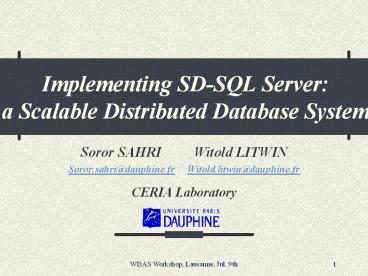Implementing SD-SQL Server: a Scalable Distributed Database System PowerPoint PPT Presentation
Title: Implementing SD-SQL Server: a Scalable Distributed Database System
1
Implementing SD-SQL Server a Scalable
Distributed Database System
- Soror SAHRI Witold LITWIN
- Soror.sahri_at_dauphine.fr Witold.litwin_at_dauphine
.fr - CERIA Laboratory
2
Overview
- Objective
- SDDS DBS Principles
- The Gross Architecture of SD-SQL Server
- Server Side
- Client Side
- Experimental Performance Analysis
- Conclusion Future Work
3
Objective
- Most of DBSs have parallel versions
- SQL Server, Oracle, DB2
- DBSs do not provide dynamically scalable tables.
- Manual reorganizing if a table scale-up.
Add a layer on DBSs Architecture
4
Objective
- Use the SDDS theory.
- Use the Distributed Partitioned Views of DBSs.
- We call the result SD-DBS Architecture
- Our prototype is SD-SQL Server.
5
SDDS Principles
- Scalable partitioning using splits of overloaded
servers. - Clients have private images of data
partitioning.
6
Distributed Partitioned Views
- Distributed Partitioned Views allow the data in
a large table to be split into smaller member
tables in distributed servers. - The data is partitioned between the member tables
based on ranges of data values. - Horizontal partitioning.
- The data ranges for each member table are defined
in a CHECK constraint specified on the
partitioning key. - A view that uses UNION ALL to combine selects of
all the member tables into a single result set is
then defined.
7
SD-SQL Server
- Marriage of SDDS DBS principles.
- Application to SQL Server 2000 DBS.
SDDS
SQL Server 2000
SD-SQL Server
Scalable tables
Scalable Distributed Views
8
Gross Architecture
9
SDDS Layer
- The SDDS Layer is composed of
- Server Side
- manages the scalable tables,
- and the split mechanism.
- Client Side
- manages the scalable distributed views.
10
SDDS Layer
Segments of a Scalable Table
DB3
DB2
DB1
Segment
Segment
Segment
Client Side
Scalable Distributed View
Scalable Distributed View
11
Server Side Scalable Tables
- The creation of a scalable table is similar to
that of any table. - With the usual CREATE TABLE statement.
- Each scalable table has a CHECK CONSTRAINT.
- Use of additional clauses related to scalable
tables and store them in meta-tables - The limit size is stored in the SD-SIZE
meta-table. - The available servers are stored in the SD-SITE
meta-table. - The actual partitioning is stored in SD-C and
SD-RP meta-tables.
12
Server Side Scalable Tables
- Example
- The creation of the scalable table Customer calls
the stored procedure CREATE_SCALABLE_TABLE - EXEC CREATE_SCALABLE_TABLE
- CREATE TABLE Customer (Customerid numeric
PRIMARY KEY), 100 - A trigger will be created on the Customer table.
It launches the split when Customer exceeds its
maximal size.
13
Server Side Split Mechanism
14
Server Side Split Mechanism
Server1.DB_1
Server2.DB_1
Customer
Customer
Split
SD_C
SD_RP
SD_C
SD_RP
Server1.DB_1 Server2.DB_1
Server1.DB_1
Server1.DB_1
Meta-tables
Meta-tables
15
Client Side
- Scalable distributed view definition is located
at each SD-SQL Server client using the scalable
table. - Clients can have different SD views of the same
scalable table. - Not include all the existing segments.
- A client meta-table C-Image contains the number
of segments of each SD view on each client.
16
Client Side
Server1.DB_1
Server2.DB_1
C-Image
C-Image
Customer
Customer
SELECT FROM Server1.DB_1.dbo.Customer UNION
ALL SELECT FROM Server2.DB_1.dbo.Customer
SELECT FROM Server1.DB_1.dbo.Customer
Customer_View
Customer_View
17
Client Side View Adjustment
Find all the scalable tables in Q
Check each scalable view
Adjust the outdate ones
Pass Q to DBS for usual execution
18
Client Side View Adjustment
- Example
- Q SELECT FROM Server2.DB_1.dbo.Customer_view,
T - 1.Find the scalable tables in Q Customer_view
- 2.Check the correctness of the view using the
SD-RP and - C-Image meta-tables.
- Count Customer segments in SD-RP as n.
- Check n and n the number in C-Image
meta-table. - 3. If nlt n then Adjust the view.
- 4.Execute Q.
19
Client Side Query Processing
- The SQL commands used for the application are
- SELECT, INSERT, UPDATE , DELETE.
- Each command is executed by a stored procedure.
- Example
- EXEC SELECT_VIEW_SITE select from
Customer_view - CREATE_SCALABLE_TABLE
- ALTER_SCALABLE_TABLE
- DROP_SCALABLE_TABLE
- CREATE_SCALABLE_VIEW
- DROP_SCALABLE_VIEW
20
Experimental Performance Analysis
- Test environment
- The hardware consisted of 1.8 GHz P4 PCs,
connected through 1Gbps Ethernet. - The experiments are used with the Customer table.
- The timing of the operations are measured using
the SQL Profiler.
21
Experim Perf Analysis Server Side
22
Experim Perf Analysis Client Side
- Example
- Lets the Customer_view definition
- CREATE VIEW Customer_view AS
- SELECT FROM Server1.DB_1.dbo.Customer.
- On Server2.DB_1, we execute Q
- INSERT INTO Customer_view VALUES (25)
23
Experim Perf Analysis Client Side
24
Experim Perf Analysis SkyServer Database
- Use of the SkyServer Database from
- the website
- http//research.microsoft.com/gray/SDSS
- Creation of PhotoObj table as a scalable table.
- Photoobj has 158 426 rows and 400 columns. Its
size is 506 MB. - Generation of two segments with the PhotoObj
split.
25
Experim Perf Analysis SkyServer Database
- The split time of The PhotoObj table is about
1mn. - The execution time of the query
- 44 sec without the view update
- and
- 45 sec with the view update.
select from PhotoObj_view WHERE (status
0x00001000 0) and NOT ( (status
0x00002000gt0) and (status 0x0010 gt0))
26
Conclusion
- Scalable Tables are now Reality
- For SD-SQL Server at least at present.
- Dynamic data partitioning.
- Splitting time is practical
- Small for small segments, larger for larger
segments. - Sub-linear with the segment size.
- Time to test a scalable view or to adjust it is
negligible. - The prototype is available in CERIA Lab.
27
Future work
- More complex SQL queries
- With subqueries, views, aliases
- Complete th SQL Libarary.
- Use of indexes to optimize the execution time of
queries. - More performance analysis with the SkyServer
database.
28
END
THANKS FOR YOUR ATTENTION
Soror.sahri_at_dauphine.fr Witold.litwin_at_dauphine.
fr

